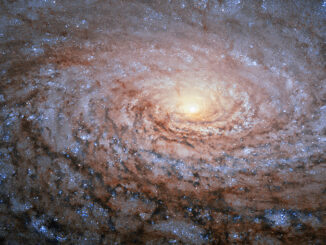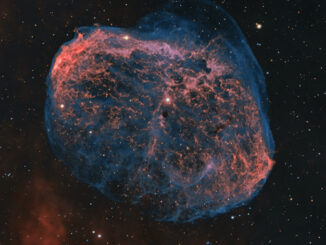
NGC 488 in Pisces is an oval-shaped face-on spiral galaxy that’s a bit of a hidden gem. It makes a fine target for a small- to medium-aperture telescope and is transformed into truly a work of art in deep amateur images, with its delicate and tightly wound spiral arms enveloping a bright central bulge providing a picturesque portrait.
How to observe
NGC 488 lies in south-eastern Pisces, a constellation well known for its hoards of galaxies led by the great spiral Messier 74, which lies just over 10 degrees to the north. Pisces’ more narrow westerly extremes, which is where the ‘Circlet’, its distinctive asterism of five stars (including gamma [γ] and iota [ι] is found, lie below the Great Square of Pegasus, with the majority of its territory found to the south-east of the familiar landmark.
NGC 488 shouldn’t be too hard to locate; find magnitude +3.8 Alrescha (alpha [α] Piscium), Pisces’ primary star, which lies in the constellation’s extreme south-western corner, where it has a boundary with Cetus. Then follow a line north-westwards for about nine degrees, passing north of magnitude +4.6 xi (ξ) Piscium and past nu (ν, mag. +4.5) Piscium to land on mu (μ, mag. +4.8) Piscium. From mu, nudge your telescope just over two degrees to locate our target.
On mid-September nights, Pisces’ eastern end is well clear of the south-eastern horizon by midnight BST (23:00 UT), with NGC 488 placed over 30 degrees up. The galaxy crosses the southern meridian (when it culminates and lies at its highest in the sky) at 2.45am (01:45 UT), lying around 44 degrees in altitude, from London).
NGC 488 has a central hub of very high surface brightness. Nevertheless, it’s still out of range of 10 <M>x<M> 50 binoculars but shines bright enough to be spotted as a smudge of nebulosity, perhaps two arcminutes in diameter, through a small telescope of around 80mm (~three inches) aperture at a magnification of 50<M>x<M>.
Deep amateur images reveal a beautiful and very well-ordered object, with multiple, evenly spaced and tightly wound spiral arms (it’s classified as SA(r)b). With increasing aperture, NGC 488’s circular, north–south orientated diffuse halo of the unresolved spiral arms grows in apparent diameter to become as large as four arcminutes through a 250–300mm (ten- to twelve-inch) telescope. You’ll need something larger though, working on a dark, moonless and transparent night, to begin to see a hint of those low surface brightness spiral arms.




